 |
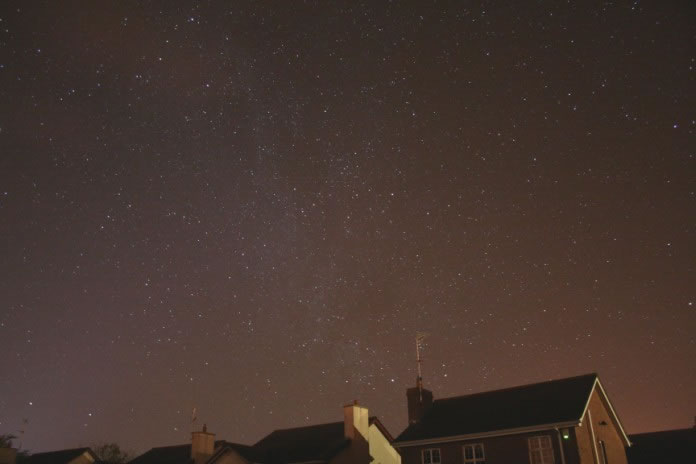 |
All IMAGES TAKEN BY CONOR MC DONALD
As the sun set in the west in advance of a good clear night I received a phone call from well known local astronomer John Mc Connell (FRAS) who informed me that he was on his way down to my home for a night of observing. I immediately contacted by observing friend Conor Mc Donald who I knew would be eager for another nights observing, especially with someone like John who has fifty years of observing experience under is belt! We knew it was going to be a late night.
As I waited for the guys to arrive I set up the 8.5" F/7 reflector (on loan from John) in the back garden during bright twilight and grabbed my 10X50mm binoculars. I looked half way up the western sky where I could see the constellation of Hercules hanging above my rooftop with his distinctive 'keystone' asterism' standing out in sharp relief from the darkening blue sky background.
Tonight Hercules contained two great star attractions, when I looked through the binoculars I could see the first one - the great Hercules star cluster known as Messier 13 (M13), a bright globular cluster containing 100,000 suns in a compact ball nesting between two 9th mag stars. However the second star attraction was my reason for being involved in astronomy for over 10 years now, not a true star as such but a 'hairy' one - a comet! Running past the eastern side of M13 was the feathered tail of C/2006 M4 SWAN, this comet suddenly flared into outburst on Oct 24th and on my previous observation two nights ago I seen it at mag 4.7 as a bright naked eye comet so I was eager to see what this bird was doing tonight. Even in such a bright sky I could faintly see the coma with the naked eye perched within the keystone above the naked eye star 40 Herculi, as the sky darkened further the sight was remarkable, the comet shared the same binocular field as 40 Herculi and M13.
I made myself comfortable on a chair and leaned back at a precarious angle and studied the comet carefully, the coma was a green moderately condensed compact object with a white central condensation at D.C 7 and its glorious gas tail extended for 4 degrees (8 full moon diameters) like a faint green torch beam who's batteries were draining. SWAN's light is draining indeed and it was apparent that the comet had faded rapidly and I estimated its magnitude at 5.0 however it was still a glorious sight as the brightest comet in the sky since 73P/ SW3 during May which brings our total to four naked eye comets during 2006. I sketched the comet in my note book which was a difficult process when holding the binoculars in one hand while sketching with the other but I got a result anyway - SKETCH.
I guided the telescope onto the comets coma and despite the low power 40mm eyepiece I was using and the uncollimated optics (it got a strong knock the previous night) I was amazed to see at least three bright jets deep in the heart of the coma (comets head). Altogether I spent 1.5 hours with the comet and finished of with a look at the coat hanger asterism in Cygnus, M27, Chi Cygni , M92 and the variable stars R & T CrB.
Poor transparency and a murky near 1st 1/4 moon low in the south subdued some of the comets glory however I vowed to keep watch on this comet - I will watch this SWAN's flutters and splashes as it swims along its starry river following its long hyperbolic path through the solar system into the frigid dark world of its aphelion but it could surprise us again, will it fade quickly? or will it flap its wings and flare into brilliance once again? - who knows. One thing is for certain, I will be watching. Or story on comets does not end here though, more on this later.
 |
By 21.00 clouds arrived to cover the sky and judging by their appearance I would have guessed we would have been overcast for the rest of the night. Shortly afterward John pulled up outside my house, his arrival was something I was looking forward to as the last time he was down we had been attending a lecture on comets by Pro. Alan Fitzsimons at Queens University, Belfast, so this would be our first observing session together from my new home. What can I say about John? well he is not your typical kind of man, in fact he arrived in a car which had been lifted off the ground by a tornado last year - enough said! John and I had tea together and knowing my interest in comets he had brought with him a present in the form of a printed photograph which he had taken during March 2002 showing the beautiful naked eye comet C/2002 C1 Ikeya - Zhang sporting a long blue gas tail which extended beyond the frame of the camera. It was a fantastic present so if you are reading this John, thank you. Soon Conor arrived who like me would not miss out on a potential observing session and his camera and tripod were already in hand as he stood outside the door. As it was cloudy we decided to do a little research on the computer. Web Connection - Disconnection EventsFirst we checked the online aurora charts as a the Earth was currently inside a solar wind stream which could cause an aurora display. The KP index was active however the oval was weak so northern latitudes would probably get a nice show and it was possible that aurora activity could extend to our location so we kept that in mind for later.
|
Next we spent a great deal of time studying the amazing images and animations of comet SWAN taken by various astrophotographers from around the world and in particular those by the famous Gerald Rhemann and Michael Jager which showed a very turbulent ion tail being buffeted by the solar wind like a wind sock, there seemed to be some evidence to suggest a disconnection event within the tail. The dust tail was faint but quite extensive on one image but seemed superimposed on the ion tail and slightly to its right, there appeared to be very faint striations in the tail indicating the presence of synchronic banding. Various images on the MPML showed 5 curving jets with their shape a possible indication of the rotating nucleus. We had a great time trying to make sense of what was going on within this comet, the details of which will stay fresh on our minds the next time we view it.
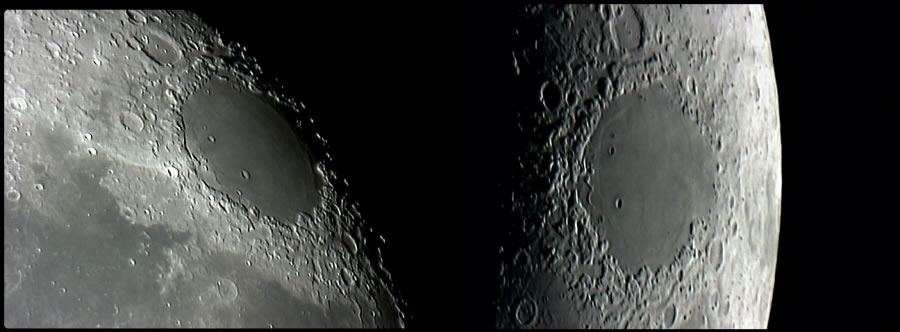 |
SUNRISE AND SUNSET OVER MARE CRISIUM BY JOHN C. MC CONNELL
John is known to us as the 'moon man' - the moon has always been his true passion in astronomy. We viewed a selection of his own lunar captures made using a 90mm ETX and Toucam pro. This turned into a fascinating tutorial on lunar observing, imaging and geology combined with historical anecdotes which John had stored to memory - after all he is an authority on astronomical history so we had no better teacher. We learned about sun angles, shadows, impacts, ejecta rays and the true shapes of the various Maria (impact basins) which pock marked the moons surface. Johns words made the moon a real and interesting place - Conor and I enjoyed the lesson.
 |
After more tea and chat we relocated to my backyard where we could see Gemini and Procyon in a few gaps. The clouds rapidly broke revealing a good quality clear dark sky with a limiting magnitude of 6. The Milky Way In Perseus, Cassiopeia, Cygnus, Orion and Gemini was impressive so we wrapped up and got dark adapted to see what the sky would reveal to us tonight. We began seeing meteors and it was quite apparent that the activity was very good which is was not surprising as the Orionid meteor shower had peaked last weak with enhanced activity (read my report) so we decided to do a count. Meanwhile using the 8.5" we had a look at various deep sky targets, on the list were comet 4P/ Faye, M31, M32, M110, M33, M1, M35, M78, M42 + 43, M81, M82 and I did a sweep through the paws of the 'Great Bear' picking up the nice edge on galaxy NGC 2841 followed by a nice view of the Merope Nebula which hugged a naked eye star in the Pleiades like a scarf. (I feature this reflection nebula in my Nov DSO's).
 |
The Gegenschein was a very large green circular glow below Aries and extending away from it was the green Zodiacal band which crossed through Taurus into the rising winter Milky Way - wonderful. I have seen it stated before that the Gegenschein can only be seen from the darkest locations on Earth however this is not so, in less than a year I have witnessed this 'elusive' phenomena no less than 28 times and that's with the lights of Maghera close by to the south. John Mc Connell himself has seen it from the outskirts of Belfast! So try for it from where you live as there is no better time than present.
The meteor activity had picked up so much that we began a proper watch. Using his new Canon 350D Conor began a photographic meteor patrol using exposures between 30 sec's and 1 min. John joined him for a visual watch while I periodically watched for meteors while observing through the telescope. I had my eye buried within a 40mm eyepiece when at 02.29 LT I heard an excited yell from Conor and John who had just seen a magnitude - 6.5 orange Orionid Fireball pass through the northern sky!
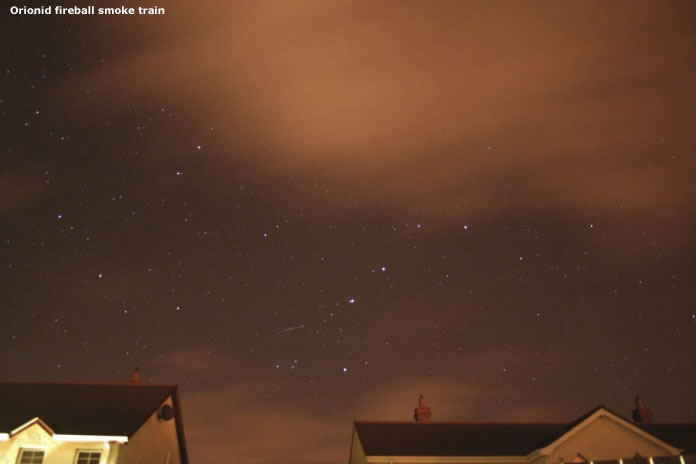 |
I missed it but they were still pointing their fingers at that sector of sky, to our amazement we could see a glowing grey/white smoke train left from the objects entry through the atmosphere, it was 5 degrees in length and located SE of Alcor & Mizar not far from the position of M101 in Ursa Major, the smoke train lasted for 1.5 min's and Conor's reactions were good. He swung his camera into position and captured two images of the train - nice work Conor!
We decided to change our location and walked a little further up the estate to an area that was even darker. Tonight the clocks went back by one hour which was great news for us, we laughed at the thought of getting an extra hour of observing in while others had an extra hour in bed. By now it was before dawn, Conor continued his camera patrol while John and I did our visual watch. Saturn was a lovely sight well placed in the NE below the sickle of Leo with Hydra the water snake to its right (now renamed 'Nessie' by us), brilliant Sirius in the SE and Orion the 'Hunter' high in the S with Lepus the 'Hare' below.
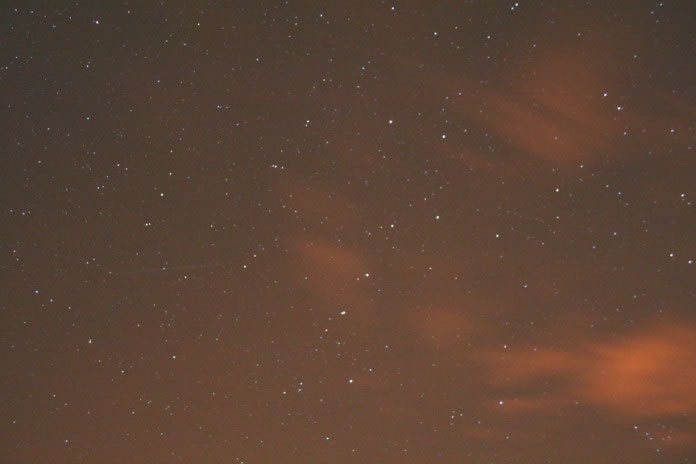 |
The meteor rate climbed and climbed and Conor ended up catching two more on his images (above & below). Conor loves photography and spent a lot of time experimenting with camera settings and angles with various foreground content and ended with several very Halloween style sky portraits of Orion and the Hyades through tree branches against an orange sky foreground.
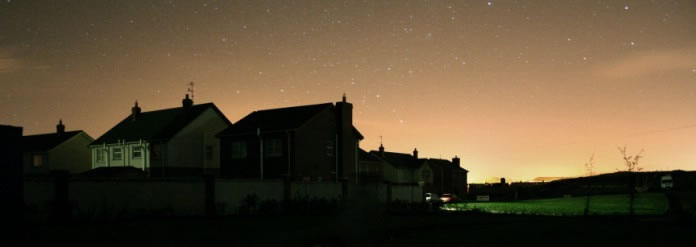 |
By 05.30 LT we had observed a grand total of 74 meteors, the majority of which were Orionids, a few sporadic's and at least one Taurid and not forgetting that stunning fireball and smoke train which was the highlight of the night! A think this was a very good count indeed.
We had a good view low down to the northern horizon which was covered by a thick film of dense murk. Hercules was rising at an angle so I reckoned I may be in with a chance of seeing comet SWAN again so I ran back to the house, retrieved my binoculars and began a careful sweep. M13 was no problem and after a little patient watching I could just make out comet SWAN as a faint hazy patch above the distant dark, tree lined horizon. It was not an impressive sight compared to its even apparition but it was quite a thrill to see the comet twice on the same night. The first as it sank in the west and a second when it rose in the north. We had watched a complete rotation of the sky and to prove it we could see Arcturus rising in the NE again! To end the night we had a look at M42, M41 and Melotte 111 in the binos.
We ended our session for tonight just as the the NE pre dawn sky was starting to brighten with the first sign of approaching dawn. We called it a night, said our good byes and John and Conor returned home feeling very happy and content with the nights observing.
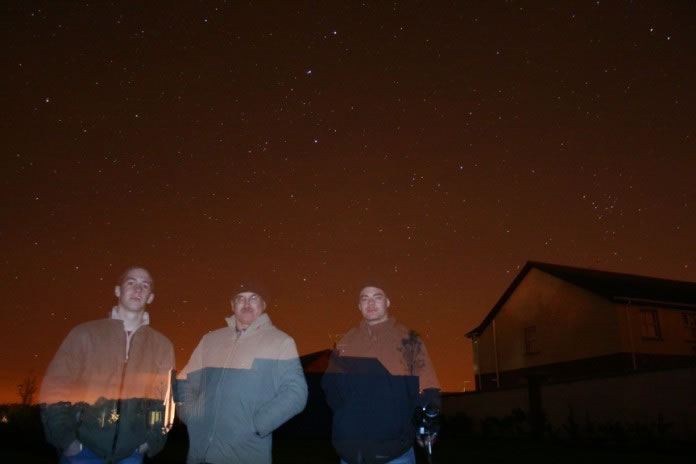 |
I had a warm mug of tea then I returned to the telescope in the back garden. A very heavy dew had descended and the telescope tube was soaking wet, it was so bad that my telrad slowly slid out of alignment (it was temporarily fixed in the OTA with blue tack) which was a little frustrating but I did not let it hinder my most favourite time of the night - the quiet half hour before dawn. I ended the night with a gentle sweep for new comets through Bootes, Coma Berenices and Virgo picking up the globular cluster M3 and the bright galaxy M64. With these two trophies I called it a night at 06.10 LT. It had been a long one as I had been observing on and off since 19.15 the previous evening. I was happy with the sky and with my company, definitely a session to remember!
This was a most enjoyable observing session, it was a pleasure spending a entire night watching an impressive number of meteors with John and Conor, the enthusiasm permeated through everyone!. Conor's imaging style was swift, effective and creative - well done on catching that smoke train and 2 meteors! John's expertise, practiced eye and love of the sky was just as obvious as that - 6.5 fireball. I enjoyed this session very much, the sky was exquisite and so was the company! We plan to meet again for the Leonid outburst on Saturday November 18th so watch this space for coverage of our next meteor watch.
Clear skies
Martin Mc kenna
Also see...